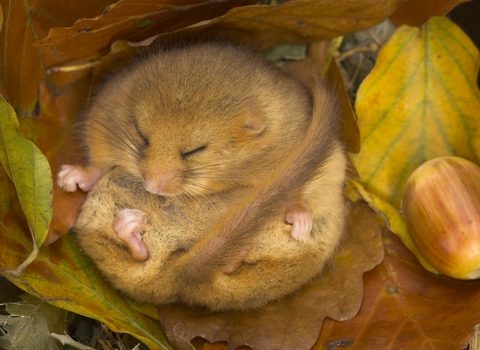
Young hazel dormouse by Terry Whittaker/2020VISION

©Danny Green
Hazel dormouse
Scientific name
Muscardinus avellanariusWhen to see
April to OctoberSpecies information
Category
Statistics
Length: 6-9cmTail: 5.7-6.8cm
Weight: 15-40g
Average lifespan: 5 years
About
Dormice are barely ever seen due to the fact they spend most of the day asleep! At night they come alive, climbing high into the trees on the hunt for a tasty snack. Their favourite foods are hazelnuts, berries and insects. Dormice build nests out of grass and leaves ready for the female to give birth to up to seven young. In autumn, dormice start looking for the perfect spot to hibernate for winter. They often choose to sleep in logs or leaves at the base of trees or just beneath the ground where they can avoid the winter cold.How to identify
The hazel dormouse has gingery-brown fur, large black eyes and a long, fluffy tail; it is much smaller than a squirrel.Distribution
Mainly found in southern England and Wales.In our area
Dormice are thriving in Suffolk Wildlife Trust reserves, including Bradfield Woods and Arger Fen.
To ensure a sustainable population and re-colonisation of nearby woods and hedges it is essential that we restore and strengthen links between woodland SSSIs.
In order to help dormice in Suffolk, it's important to know where they are. By recording any sightings or evidence of these legally protected mammals, from nests to nutshells, you can help keep Suffolk a dormouse stronghold.
Did you know?
Hazel dormice, like many of our other small animals, hibernate through the winter months in order to survive. If food is scarce outside of hibernation season, they can save energy by dropping their body temperature and going into a state of 'torpor'. In fact, dormice can spend nearly three-quarters of the year 'asleep' in some form!Dormice are thriving in Suffolk Wildlife Trust reserves, including Bradfield Woods and Arger Fen.
To ensure a sustainable population and re-colonisation of nearby woods and hedges it is essential that we restore and strengthen links between woodland SSSIs.
In order to help dormice in Suffolk, it's important to know where they are. By recording any sightings or evidence of these legally protected mammals, from nests to nutshells, you can help keep Suffolk a dormouse stronghold.
